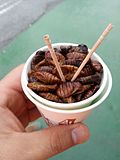Sericulture
Sericulture, also called silk farming, is the process of making silk fibers. It starts by raising silkworms and then processing the fibers they produce. Silk fibers are combined into silk thread. The thread can then be twisted into silk yarn or woven into silk cloth (fabric).
Production
Stages of production
The stages of production are as follows:
- The silk moth lays thousands of eggs.
- The silk moth eggs hatch to form larvae or caterpillars, known as silkworms.
- The larvae feed on mulberry leaves.
- Having grown and moulted several times, the silkworm pushes out silk fibers to make a net to hold itself.
- It swings its head from side to side in a figure '8' distributing the saliva that will form silk.
- The silk solidifies when it contacts the air.
- The silkworm spins approximately one mile of filament (fiber) and completely encloses itself in a cocoon. This takes about two or three days.
- The whole cocoons are picked and boiled, killing the silkworm pupa.
- The silk is obtained by brushing the undamaged cocoon to find the outside end of the filament.
- The silk filaments are then wound on a reel.
The amount of usable quality silk in each cocoon is small. As a result, about 2500 silkworms are required to produce a pound of raw silk.[1]
One cocoon contains approximately 1,000 yards of silk filament. The silk at the winding stage is known as "raw" silk. One thread is made up of as many as 48 individual silk filaments.
Sericulture Media
Equipment for unravelling silk cocoons, Khotan
References
- ↑ "Silk Making: How to Make Silk". TexereSilk.com. Archived from the original on 26 May 2014. Retrieved 25 May 2014.
Other websites
| Wikimedia Commons has media related to Lua error in Module:Commons_link at line 62: attempt to index field 'wikibase' (a nil value).. |
- The History of Sericulture Archived 2009-09-27 at Archive-It, from the Smithsonian magazine
- Central Silk Board of India Archived 2017-11-06 at the Wayback Machine
- Silk Production Process
- Sericultural Research & Training Institute of Mysore, India Archived 2010-05-12 at the Wayback Machine
- Central Sericultural Germplasm Resources Centre Ministry of Textiles, Government of India Archived 2015-05-10 at the Wayback Machine
- Sericulture in the India Development Gateway
- Silkworm Life cycle (photos)
- Raising silkworms in your classroom, including photos
- "Livelihood - Hanging by a Thread"
- A bitter-sweet story







